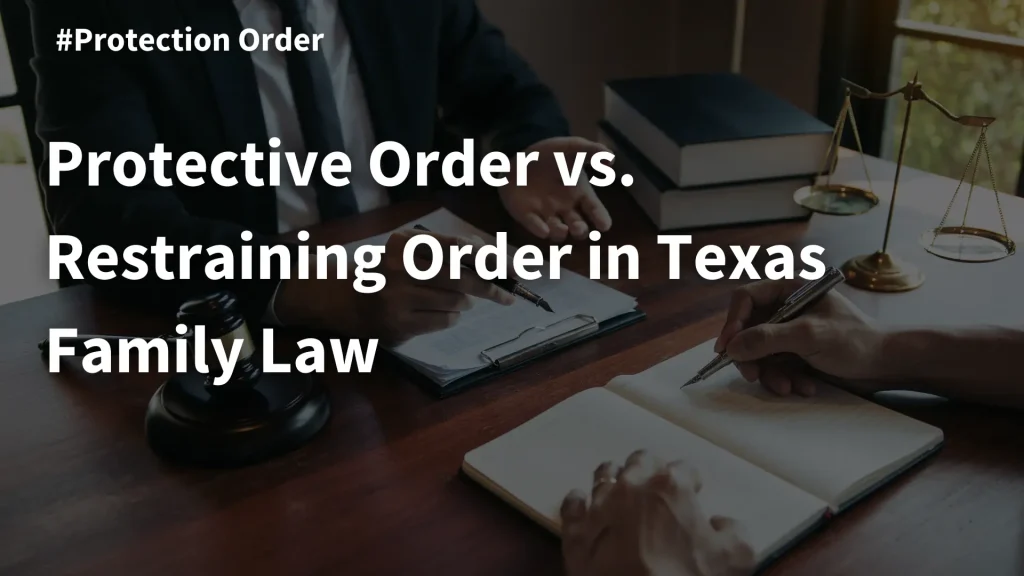During family disputes or following incidents of abuse, harassment, or violence, individuals may seek a protective order or restraining order from a family court. Under Texas law, courts may issue protective orders after a person commits an act of violence against a family or household member. In contrast, family courts may use restraining orders during legal proceedings, such as divorce or child custody cases, to restrict the parties’ contact to maintain civility or to preserve the financial and legal status quo during the case. An experienced family law attorney can help you understand the differences between a protective order vs. restraining order under Texas law and when you might need one, as well as assist you with obtaining an order that protects your rights and interests.
Understanding a Texas Protective Order
Under the Texas Family Code, a court may issue a protective order upon finding that a person has committed family violence against a member of their family or household or a current or former dating partner. Family violence occurs when a person commits an act that causes physical harm, injury, or sexual assault or threatens a victim with imminent harm or injury. A protective order typically requires a person who commits family violence to refrain from specific actions; these prohibitions help reduce the risk of future acts of family violence.
What Are Some Typical Components of Protective Orders?
Common restrictions found in protective orders include:
- An obligation to complete a battering intervention and prevention program or counseling with a social worker, family service agency, physician, psychologist, licensed therapist, or licensed professional counselor with family violence intervention training
- Not committing future acts of family violence
- Not communicating with a person protected by the order or a member of that person’s family or household
- Not sending or making threats towards a person protected by the order or a member of that person’s family or household
- Not going to or near the residence or place of business or employment of a person protected by the order or a member of that person’s family or household
- Not engaging in harassing, annoying, alarming, abusive, or embarrassing conduct toward a person protected by the order or a member of that person’s family or household
- Not possessing a firearm unless employed as a sworn, full-time peace officer (the court can also suspend the person’s handgun license)
- Not harming, threatening, or interfering with the care of a pet, companion animal, or service animal owned by a person protected by the order or a member of that person’s family or household
- Not tracking or monitoring the personal property or a motor vehicle of a person protected by the order or a member of that person’s family or household, either through electronic tracking means or physically following an individual or their property
Courts can issue temporary orders that remain in effect until the court holds a hearing to determine whether to issue a general protective order, which can, in most cases, last up to two years. Parties can request a protective order’s modification to add or remove restrictions.
Understanding a Texas Restraining Order
In Texas, a court may issue a restraining order in a civil proceeding to order a party to stop engaging in and refrain from specific conduct or behavior. A court may issue a restraining order in a divorce or child custody proceeding to maintain civility and decorum during the proceedings. Restraining orders can restrict how and when parties in a case interact with one another, such as requiring the parties to communicate through legal counsel or restricting direct communication to specific topics, such as child custody or parenting decisions. Courts can also use restraining orders to maintain a financial or legal status quo during the proceedings, including by ordering parties not to access or transfer any money or property in dispute.
Differences of Protective Order vs. Restraining Order
Protective orders and restraining orders in Texas have several critical differences. First, protective orders arise in the context of domestic or family violence, giving a person subjected to such violence protection from future acts of violence by their abuser or harasser. Conversely, courts use restraining orders during civil cases to keep the parties’ interactions polite or to maintain some status quo. Protective orders can last up to two years, whereas restraining orders usually only last for weeks or months. However, courts can continue restraining orders for more extended periods than protective orders if required by the circumstances of a civil case, such as during complex litigation that lasts several years.
What Happens When Violations Occur?
When a person subject to a protective order violates the restrictions in the order, they may face various penalties. A party protected by the order can report a violation to law enforcement or the court. The court can hold a contempt hearing and hold the violator in contempt of court, resulting in penalties that include fines up to $500 and up to six months in jail. Authorities can also prosecute violations for knowingly breaching the restrictions of a protective order, with penalties of up to $4,000 in fines and up to 12 months in jail. Violations constituting separate criminal offenses can also result in separate prosecutions and sentences.
Conversely, when a party violates a restraining order, the non-breaching party must seek civil relief from the court that issued the restraining order. In most cases, the court will hold a hearing to determine whether a violation has occurred and impose appropriate sanctions, such as monetary penalties or modifying the restrictions in the restraining order.
Contact Our Dedicated Texas Family Law Attorneys Today
If you have experienced domestic violence, harassment, or stalking or your family law case has led to abusive or harassing communications between you and your ex, a protective or restraining order can help restore your safety and peace of mind. Contact Smith & Bledsoe Family Law today for a free case evaluation with our experienced family law attorneys to discuss your rights and options for obtaining a protective or restraining order in Texas.

